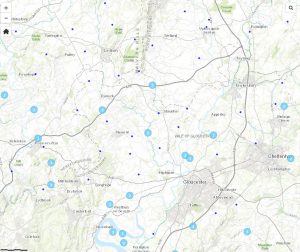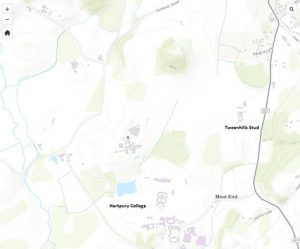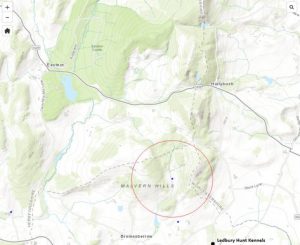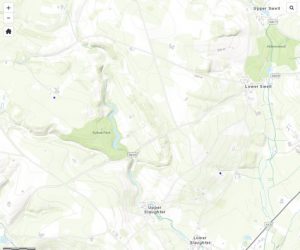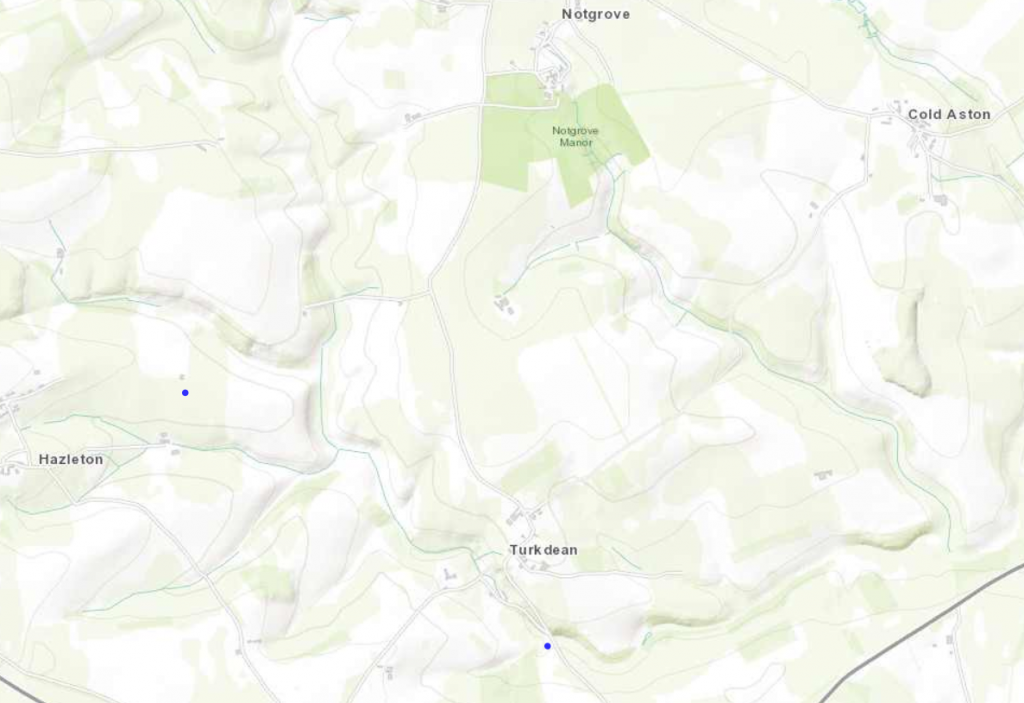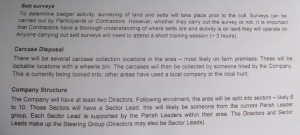Please check out the facebook page and website of the Gloucestershire Badger Office – born out of the project started by 3C Sabs in 2013…
The government has been carrying out badger culling in Gloucestershire since the autumn of 2013 when the 6-week cull was granted an 8-week extension when they failed to reach their minimum kill-target. This extension was then cancelled early (after just over 5 weeks) when they realised they didn’t have a chance of reaching the minimum number within the extension period.
These culls take place only a few years after the end of the Krebs trials. These trials took place in several areas over 10 years, an independent body assessing what effect culling would have on the prevalence of bovine tuberculosis. At the end of the trials it was determined that culling did not have enough of an impact on btb for it to be worthwhile. Bad ethics, bad science.
The Gloucestershire cull zone is right in the centre of our ‘sabbing country’, most of it covering a part of Gloucestershire and then extending into Herefordshire and Worcestershire. We were already aware of various badger setts within hunted areas due to suspected persecution by hunt staff, hunt supporters and some local farmers and we then put in many days of looking for others prior to the first cull and between each cull since.
Badger culling has also taken place in Somerset since September 2013 and the cull also started in Dorset in autumn of 2015. Widescale resistance against culling has taken place over the last few years with people traveling from all over the country (and from further afield) to find and check setts and deter shooters.
Roll-out to several new zones happened in 2016 and further roll-out occurred in following years (and more expected in coming years) our sab group has moved away from coordinating resistance on a wider scale against the cull and are focusing on wildlife crime as a whole. We’ll still be paying a lot of attention to the cull, especially as it is taking place in larger parts of Worcestershire, Herefordshire and Gloucestershire in the future – the three counties that we operate in.
The general public have the chance to comment on new badger culling applications as and when they get released. In April 2017 it was for wider parts of Gloucestershire, Somerset and Dorset and for a license for Wiltshire. Here’s how we responded publicly:
How can culling continue to be licensed when there are so many biosecurity breaches in current and future cull areas, when badgers are being disturbed and increased perturbation risked, when people, hunt hounds and vehicles are traipsing around the countryside from farm to farm, badger sett to farmyards, back to setts, through fields of animals and back to farms?
The interactive map commissioned by DEFRA and the Welsh Government shows areas where bTB has been found in cattle. Roger Warner’s beef farm in Tirley is a meet for the Ledbury Hunt… at the end of season meet two years ago a fox was marked to ground in a badger sett by the hounds – the sett was then blocked by terriermen and supporters. This was the last bit of the day before the hunt packed up at Townstreet Farm, supporters heading back there for drinks and a social.
The pictures shared here are of the map… we have only chosen a few examples of areas. We are not saying that the hunts are responsible for the spread of bTB to these areas, but are questioning how they are still being welcomed into these areas, especially when they are blocking setts and running foxes to ground in them on a regular basis.
The first picture is of the Gloucestershire cull zone and its surroundings. The Cotswold Vale Farmers’ Hunt, the Ledbury Hunt and the Ross Harriers all operate within large parts of it. Each of them has been caught marking foxes to ground in setts, digging them out or blocking them (the CVFH do not seem to block setts, but the terriermen were caught by a sab at a sett on Boxing Day).
The second picture shows an area in Hartpury where Hartpury College is marked with a blue dot, indicating an outbreak of bTB within the last few years. We have marked Tweenhills Farm and Stud on the map nearby which is owned by David Redvers, a Master of the Ledbury Hunt and is used as a meet for the hunt throughout the hunting season. Within this same area there are 5 separate badger setts which have been blocked time and time again. Within the Gloucestershire zone sett blocking has decreased somewhat over the last few years due to the higher number of people checking setts and the awareness raised in the area of these activities. However sett-blocking does still occur and a back-filled dig-out site has also been found in onoe area which we believe is from earlier this season. One of the 5 setts was almost destroyed earlier this season too and struggled to recover.
The third picture is of the Malvern Hills. Within the radius drawn on to the map around the blue bTB dot is a badger sett which was dug out by the hunt during cubbing this season and which has been repeatedly blocked by the hunt presumably over the years as well as this season – it will be monitored more regularly now that we know of its presence. The owner of the land also hosts hunt meets on his estate nearby. Just as worrying are the reports that we receive about Eastnor Castle and the behaviour of gamekeepers there… even the huntsman of the Ledbury Hunt (whose kennels are to the south of this part of the map) has told us that all of the badgers have been killed or moved on from around the Castle.
Picture number four shows an area near to Stow-on-the-Wold where we visited the Heythrop Hunt last month and where we found 9 blocked setts which had either been blocked the night before or on the morning of the hunt meet. The map shows 2 blue dots indicating bTB presence. These setts have been blocked repeatedly over the seasons.
Lastly, a picture of the Cold Aston / Hazelton / Turkdean area which we have been in on numerous occasions. The Heythrop Hunt and the Cotswold both hunt in this area and on one occasion in December of this season both hunts blocked the same setts just a week apart from each other. On another occasion the Heythrop Hunt, the Cotswold Hunt and the Dummer Beagles all hunted this srea within the same week, within the same 5-day period. The Heythrop and Cotswold both blocked badger setts during that week.
These last 2 pictures show areas within the North Cotswolds part of the Gloucestershire cull zones.
Additionally, hounds are fed fallen stock and slaughterhouse by-products, none of which is tested for bTB and which is suspected to be the cause of the outbreak of bTB in the Kimblewick Hunt hounds in February. Hounds “empty” themselves where and when they want and no one really cleans it up. They also run directly over farmland and through herds of cattle and sheep, through fields spread with slurry and have even been rescued from slurry pits before running on. Horses and quads can turn fields into quagmires when there are wet conditions and potentially carry infection from one farm to another.
In 2016 documents were leaked to us regarding a potential new ‘southern’ zone. Here’s what our good friends at Gloucestershire Badger Office wrote about the future:
As the foxhunting season starts to draw to a close, groups are beginning to focus more time on sett-surveying, sett-checking and preparing for the expected further roll-out this year. Many lessons have been learned over the last 4 years and we will continue to learn and adapt our tactics in order to target culling and other forms of wildlife persecution.
Whatever happens in the ‘original’ Gloucestershire cull zone, Gloucestershire Badger Office intends to keep fighting within the ‘northern zones’ and to give advice and support to zones further afield. We received leaked documents some time ago regarding a potential new zone that would become active this year and locals in the area are working hard on researching and preparing for the cull in that area. We will let them announce it when they’re ready to…
In the meantime, we wanted to share parts of the documents received to reiterate a few of the things we spotted over the last few years. For example, much like our own work, someone will be centrally plotting setts on maps for the zone.
The NFU will still be around to assist but the main body of work is to be done locally. For example, sett-surveying is to be done by the landowners themselves (or those they have nominated) – setts are to be marked on maps using red crosses and the training session which must be completed prior to sett-surveying the land will be around 2 hours long.
The first year of culling in Gloucestershire saw a huge number of new vehicles and shooters coming in from other areas as contractors. Over the following 2 years we saw far fewer ‘outsiders’ being brought in. From year 2 onwards we were aware that much more of the actual culling work was being done by locals, landowners and their friends themselves. This is the case for new zones as lessons have been learned from the original pilot areas… landowners themselves will be their own contractors, trapping and shooting or ‘free-shooting’ badgers themselves. They can also nominate someone to act as a contractor for them, for example if they do not have the required firearms licence. Of course, this allows for a contractor to work for more than one landowner, potentially then working in more than one zone. We believed this would happen in the ‘northern zones’ (Glos, North Cots, Here) which was later confirmed as being the case with some contractors and it may be seen in other areas where different zones are close together.
Cage-trapping is encouraged as “it is discrete and effective” – another ‘lesson learned’ from original zones.
If land is rented and has a tenancy of less than 4 years, the landlord must countersign in order for culling to take place on that land. However, if the tenancy is longer than 4 years the landlord does not have to countersign for it.
Other notes:
– 70% enrolment is still required in each area (i.e. 70% of the land considered ‘the zone’ must be signed up to the cull)
– each participant must be signed up for a 4-year commitment
– as in the current cull zones, there will be several disposal areas for bodies – mainly farms, but local hunts may also be used*
*considering the recent news of the Kimblewick hunt hounds contracting tb and given the number of breaches of cull guidelines by contractors observed in the various cull zones over the last few years surely this should be reconsidered
Watch this space for more information and for our upcoming ‘local groups advice’. With roll-out spreading further we believe that local-led initiatives against wider wildlife persecution is going to be the way forward. More on that soon…
GBO

